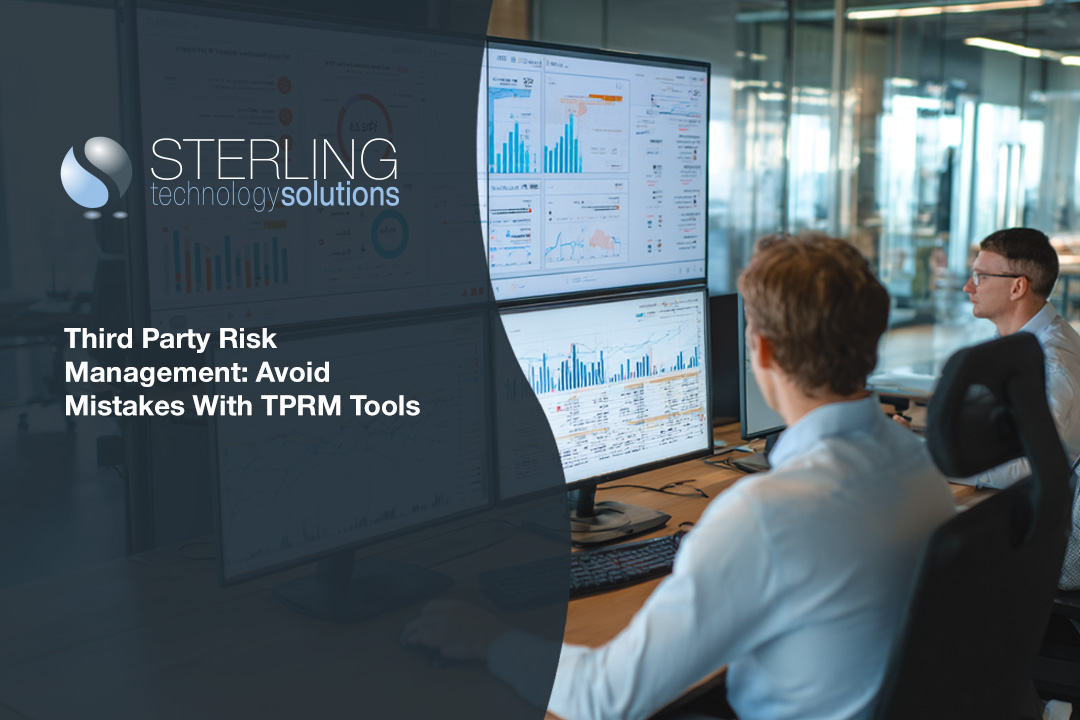Third Party Risk Management: Avoid Mistakes With TPRM Tools
October 15, 2025

Managing third-party relationships is no longer just about contracts and cost. With more vendors accessing your systems and data, the risks have grown—especially for small to mid-sized businesses. In this blog, you’ll learn what third party risk management is, why it matters, and how to build a reliable program. We’ll also cover key tools, common mistakes, and best practices to help you reduce vendor risk and improve your IT vendor management approach.
What is third party risk management?
Third party risk management (TPRM) is the process of identifying, assessing, and controlling risks that come from working with external vendors, suppliers, or service providers. These third parties often have access to your systems, data, or customers, which means their weaknesses can become your problems.
A strong TPRM program helps you protect your business from data breaches, compliance issues, and operational disruptions. It also supports better decision-making by giving you a clear view of the risks involved in each third-party relationship. Whether you're working with software providers, cloud services, or outsourced IT support, managing third-party risk is essential.

Key steps to reduce third-party risks and improve TPRM
To build an effective third party risk management program, you need to follow a structured process. Here are the key actions that help reduce risk and strengthen your vendor relationships.
Step #1: Identify all third parties
Start by listing every vendor, supplier, or contractor your business works with. This includes IT providers, cloud platforms, and even consultants. Knowing who has access to your systems or data is the first step in managing risk.
Step #2: Classify risk levels
Not all vendors pose the same level of risk. Group them by how critical they are to your operations and what kind of data they access. This helps you focus your efforts where they matter most.
Step #3: Perform risk assessments
Use a structured risk assessment to evaluate each vendor’s security practices, financial stability, and compliance history. This gives you a clearer picture of potential issues before they impact your business.
Step #4: Conduct due diligence
Before signing any contracts, dig deeper into the vendor’s background. Review their certifications, audit reports, and incident history. Due diligence helps you avoid surprises later.
Step #5: Monitor ongoing performance
Risk doesn’t stop after onboarding. Set up regular reviews and performance checks to ensure vendors continue to meet your standards. This is especially important for IT vendor management.
Step #6: Plan for exit strategies
Every vendor relationship ends eventually. Have a plan in place to transition services, recover data, and protect your systems when that time comes.
Step #7: Document everything
Keep clear records of risk assessments, contracts, and communications. This supports compliance and helps you respond quickly if issues arise.
Essential features of a strong TPRM program
A well-built TPRM program includes these core elements:
- Clear policies for selecting and managing third-party vendors
- Standardized risk assessment templates and scoring systems
- Automated workflows for onboarding and monitoring
- Centralized documentation and audit trails
- Integration with IT vendor management tools
- Regular training for staff involved in vendor oversight

Why lifecycle management matters in TPRM
The third-party relationship doesn’t end after onboarding. Managing the full lifecycle—from selection to offboarding—is critical to reducing long-term risk. Each stage presents different challenges. For example, onboarding may focus on due diligence, while ongoing monitoring looks at performance and compliance.
A structured management lifecycle helps you stay proactive. It ensures that vendors continue to meet your expectations and that any changes in their risk profile are addressed quickly. This approach also supports better alignment with your business goals and regulatory requirements.
Tools and software that support third-party risk management
Technology plays a big role in making TPRM more efficient. The right tools can automate tasks, improve visibility, and reduce human error. Here are some key types of software to consider.
Tool #1: Risk management software
This software helps you track, score, and manage risks across all vendors. It often includes dashboards, alerts, and reporting features to keep your team informed.
Tool #2: Third-party management software
These platforms focus on the full vendor lifecycle, from onboarding to offboarding. They support contract management, performance tracking, and compliance checks.
Tool #3: Compliance monitoring tools
These tools scan for regulatory changes and help ensure your vendors stay compliant. They’re especially useful in industries with strict rules.
Tool #4: Security rating services
Some platforms provide real-time security scores for vendors based on external data. This helps you identify cyber risk early.
Tool #5: Document management systems
Centralized storage for contracts, risk assessments, and audit logs makes it easier to stay organized and respond to issues quickly.
Tool #6: Communication and collaboration tools
Clear communication is key to managing third-party relationships. Tools that support secure messaging and shared workflows can improve coordination.

How to implement a third-party risk management program
Getting started with TPRM doesn’t have to be overwhelming. Begin by defining your goals and identifying the vendors that matter most. Then, build a simple risk management framework that includes assessment templates, review schedules, and documentation standards.
Next, assign roles and responsibilities. Make sure someone owns the process and that your team is trained on how to manage third-party risk. Finally, choose tools that fit your size and budget. Even small businesses can benefit from basic automation and centralized tracking.
Best practices for managing third-party risk
Follow these proven practices to improve your TPRM efforts:
- Start small and scale your program over time
- Focus on high-risk vendors first
- Use consistent risk scoring methods
- Review vendor performance regularly
- Update your risk assessments annually or after major changes
- Align your TPRM program with industry standards
These steps help you stay ahead of potential issues and build stronger vendor relationships.

How Sterling can help with third party risk management
Are you a business with 20 to 80 employees looking for a better way to manage vendor risk? If you're growing and working with more IT providers, cloud services, or external partners, now is the time to build a smarter third party risk management program.
At Sterling, we help businesses like yours reduce risk, improve compliance, and simplify vendor oversight. Our team offers tailored third-party risk management solutions that fit your size, industry, and goals. Let’s talk about how we can support your IT vendor management strategy.
Frequently asked questions
What is the biggest risk when working with third parties?
The biggest risk is a data breach caused by poor security practices from a vendor. Many third parties have access to sensitive systems or customer data. If their defenses are weak, your business could suffer the consequences. This type of third-party risk can lead to financial loss, legal issues, and damage to your reputation.
To reduce this risk, include cyber risk checks in your vendor risk management process. Make sure your third-party ecosystem is regularly reviewed and updated. A strong TPRM program helps you stay ahead of these threats.
How often should I perform a third-party risk assessment?
You should assess third-party risk at least once a year or whenever there’s a major change in the vendor’s services. Regular risk assessments help you catch issues early and keep your business protected. They’re especially important for vendors with access to critical systems.
Use a structured risk management framework to guide your reviews. This ensures consistency and helps you track changes in risk exposure over time. It also supports compliance with industry standards.
What is the difference between inherent risk and residual risk?
Inherent risk is the level of risk a vendor poses before any controls are applied. Residual risk is what remains after you’ve put safeguards in place. Understanding both helps you decide how much risk you’re willing to accept.
This is key to managing third-party relationships effectively. Your risk tolerance and risk appetite should guide how you respond to each vendor’s profile. It’s also a good way to align your TPRM teams around shared goals.
How do I know if my TPRM program is effective?
An effective third-party risk management program will reduce incidents, improve compliance, and support better vendor decisions. You’ll also see fewer surprises during audits or contract renewals.
Track metrics like risk scores, incident response times, and vendor performance. These indicators show whether your program is working. Aligning your efforts with a clear management lifecycle also helps ensure long-term success.
What should I include in my due diligence process?
Your due diligence should cover financial health, security practices, compliance history, and references. You should also review any past incidents or legal issues. This helps you avoid risky vendors.
Make sure your process is consistent across all third-party suppliers. Use checklists and templates to streamline the work. This approach supports better risk and compliance outcomes.
Can small businesses afford third-party risk management software?
Yes, many tools are designed for small to mid-sized businesses. Look for third-party risk management solutions that offer flexible pricing and easy setup. Some platforms even offer free tiers or trial periods.
The right software can save time and reduce errors. It also helps you manage risk across multiple vendors without adding headcount. This makes it easier to scale your TPRM lifecycle as your business grows.



